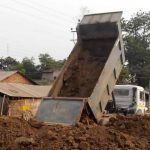Pavements are a conglomeration of materials. These materials, their associated properties, and their interactions determine the properties of the resultant pavement. Thus, a good understanding of these materials, how they are characterized, and how they perform is fundamental to understanding pavement. The materials which are used in the construction of highway are of intense interest to the highway engineer. This requires not only a thorough understanding of the soil and aggregate properties which affect pavement stability and durability, but also the binding materials which may be added to improve these pavement features.
Sub grade soil
Soil is an accumulation or deposit of earth material, derived naturally from the disintegration of rocks or decay of vegetation, that can be excavated readily with power equipment in the field or disintegrated by gentle mechanical means in the laboratory. The supporting soil beneath pavement and its special under courses is called sub grade. Undisturbed soil beneath the pavement is called natural sub grade. Compacted sub grade is the soil compacted by controlled movement of heavy compactors.
Desirable properties
The desirable properties of sub grade soil as a highway material are
- Stability
- Incompressibility
- Permanency of strength
- Minimum changes in volume and stability under adverse conditions of weather and ground water
- Good drainage, and
- Ease of compaction
Soil Types
- Gravel: These are coarse materials with particle size under 2.36 mm with little or no fines contributing to cohesion of materials.
- Moorum: These are products of decomposition and weathering of the pavement rock. Visually these are similar to gravel except presence of higher content of fines.
- Silts: These are finer than sand, brighter in color as compared to clay, and exhibit little cohesion. When a lump of silty soil mixed with water, alternately squeezed and tapped a shiny surface makes its appearance, thus dilatancy is a specific property of such soil.
- Clays: These are finer than silts. Clayey soils exhibit stickiness, high strength when dry, and show no dilatancy. Black cotton soil and other expansive clays exhibit swelling and shrinkage properties. Paste of clay with water when rubbed in between fingers leaves stain, which is not observed for silts.
Tests on soil
Sub grade soil is an integral part of the road pavement structure as it provides the support to the pavement from beneath. The sub grade soil and its properties are important in the design of pavement structure. The main function of the sub grade is to give adequate support to the pavement and for this the sub grade should possess sufficient stability under adverse climatic and loading conditions. Therefore, it is very essential to evaluate the sub grade by conducting tests.
The tests used to evaluate the strength properties of soils may be broadly divided into three groups:
- Shear tests
- Bearing tests
- Penetration tests
Shear tests are usually carried out on relatively small soil samples in the laboratory. In order to find out the strength properties of soil, a number of representative samples from different locations are tested. Some of the commonly known shear tests are direct shear test, triaxial compression test, and unconfined compression test. Bearing tests are loading tests carried out on sub grade soils in-situ with a load bearing area. The results of the bearing tests are influenced by variations in the soil properties within the stressed soil mass underneath and hence the overall stability of the part of the soil mass stressed could be studied.
Penetration tests may be considered as small scale bearing tests in which the size of the loaded area is relatively much smaller and ratio of the penetration to the size of the loaded area is much greater than the ratios in bearing tests. The penetration tests are carried out in the field or in the laboratory.
California Bearing Ratio Test
California Bearing Ratio (CBR) test was developed by the California Division of Highway as a method of classifying and evaluating soil-sub grade and base course materials for flexible pavements. CBR test, an empirical test, has been used to determine the material properties for pavement design. Empirical tests measure the strength of the material and are not a true representation of the resilient modulus. It is a penetration test wherein a standard piston, having an area of 3 in![]() (or 50 mm diameter), is used to penetrate the soil at a standard rate of 1.25 mm/minute. The pressure up to a penetration of 12.5 mm and it’s ratio to the bearing value of a standard crushed rock is termed as the CBR.
(or 50 mm diameter), is used to penetrate the soil at a standard rate of 1.25 mm/minute. The pressure up to a penetration of 12.5 mm and it’s ratio to the bearing value of a standard crushed rock is termed as the CBR.
In most cases, CBR decreases as the penetration increases. The ratio at 2.5 mm penetration is used as the CBR. In some case, the ratio at 5 mm may be greater than that at 2.5 mm. If this occurs, the ratio at 5 mm should be used. The CBR is a measure of resistance of a material to penetration of standard plunger under controlled density and moisture conditions. The test procedure should be strictly adhered if high degree of reproducibility is desired. The CBR test may be conducted in re-moulded or undisturbed specimen in the laboratory. The test is simple and has been extensively investigated for field correlations of flexible pavement thickness requirement.
Test Procedure
- The laboratory CBR apparatus consists of a mould 150 mm diameter with a base plate and a collar, a loading frame and dial gauges for measuring the penetration values and the expansion on soaking.
- The specimen in the mould is soaked in water for four days and the swelling and water absorption values are noted. The surcharge weight is placed on the top of the specimen in the mould and the assembly is placed under the plunger of the loading frame.
- Load is applied on the sample by a standard plunger with dia of 50 mm at the rate of 1.25 mm/min. A load penetration curve is drawn. The load values on standard crushed stones are 1370 kg and 2055 kg at 2.5 mm and 5.0 mm penetrations respectively.
- CBR value is expressed as a percentage of the actual load causing the penetrations of 2.5 mm or 5.0 mm to the standard loads mentioned above. Therefore,

- Two values of CBR will be obtained. If the value of 2.5 mm is greater than that of 5.0 mm penetration, the former is adopted. If the CBR value obtained from test at 5.0 mm penetration is higher than that at 2.5 mm, then the test is to be repeated for checking. If the check test again gives similar results, then higher value obtained at 5.0 mm penetration is reported as the CBR value. The average CBR value of three test specimens is reported as the CBR value of the sample.
Plate Bearing Test
Plate bearing test is used to evaluate the support capability of sub-grades, bases and in some cases, complete pavement. Data from the tests are applicable for the design of both flexible and rigid pavements. In plate bearing test, a compressive stress is applied to the soil or pavement layer through rigid plates relatively large size and the deflections are measured for various stress values. The deflection level is generally limited to a low value, in the order of 1.25 to 5 mm and so the deformation caused may be partly elastic and partly plastic due to compaction of the stressed mass with negligible plastic deformation. The plate-bearing test has been devised to evaluate the supporting power of sub grades or any other pavement layer by using plates of larger diameter. The plate-bearing test was originally meant to find the modulus of sub grade reaction in the Westergaard’s analysis for wheel load stresses in cement concrete pavements.
Test Procedure
- The test site is prepared and loose material is removed so that the 75 cm diameter plate rests horizontally in full contact with the soil sub-grade. The plate is seated accurately and then a seating load equivalent to a pressure of 0.07 kg/cm2 (320 kg for 75 cm diameter plate) is applied and released after a few seconds. The settlement dial gauge is now set corresponding to zero load.
- A load is applied by means of jack, sufficient to cause an average settlement of about 0.25 cm. When there is no perceptible increase in settlement or when the rate of settlement is less than 0.025 mm per minute (in the case of soils with high moisture content or in clayey soils) the load dial reading and the settlement dial readings are noted.
- Deflection of the plate is measured by means of deflection dials; placed usually at one-third points of the plate near it’s outer edge.
- To minimize bending, a series of stacked plates should be used.
- Average of three or four settlement dial readings is taken as the settlement of the plate corresponding to the applied load. Load is then increased till the average settlement increase to a further amount of about 0.25 mm, and the load and average settlement readings are noted as before. The procedure is repeated till the settlement is about 1.75 mm or more.
- Allowance for worst subgrade moisture and correction for small plate size should be dealt properly.
- Calculation A graph is plotted with the mean settlement versus bearing pressure (load per unit area) as shown in Figure . The pressure corresponding to a settlement is obtained from this graph. The modulus of subgrade reaction is calculated from the relation.
| (1) |
Summary
The quality of any pavement is affected by the materials used for construction. Coming to the subgrade, soil is the most important material. Here we have seen various tests used for finding the strength of soil, the prominent ones being CBR and plate load test. CBR test assesses the strength of soil, whereas plate load test is used to evaluate its support capability.





